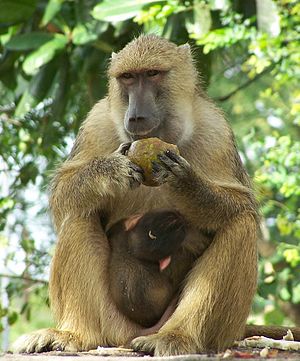Yellow baboon
| Yellow Baboon | |
|---|---|

| |
| Scientific classification | |
| Kingdom: | |
| Phylum: | |
| Class: | |
| Order: | |
| Family: | |
| Genus: | |
| Species: | P. cynocephalus
|
| Binomial name | |
| Papio cynocephalus (Linnaeus, 1766)
| |
The Yellow Baboon (Papio cynocephalus) is a baboon from the Old World monkey family.
This monkey is called Cynocephalus, derived from the Greek kunos and kephalos, due to the shape of its muzzle and head. It has a slim body with long arms and legs and a yellowish-brown hair. It resembles the Chacma Baboon but is smaller and its muzzle is not as elongated. The hairless face is black, framed with white sideburns. Males can grow to about 84 cm, females to about 60 cm. It has a long tail which grows to be nearly as long as the body.

The Yellow Baboon inhabits savannas and light forests in the eastern Africa, from Kenya and Tanzania to Zimbabwe and Botswana. It is diurnal, terrestrial, and lives in complex mixed gender social groups. It is omnivorous with a preference for fruits, but it also eats other plant parts as well as insects and small vertebrate animals.
There are three subspecies of the Yellow Baboon:
- Papio cynocephalus cynocephalus (typical Yellow Baboon)
- Papio cynocephalus ibeanus (Ibean Baboon)
- Papio cynocephalus kindae (Kinda Baboon)
References
- Template:IUCN2006
- Groves, C. P. (2005). Wilson, D. E.; Reeder, D. M. (eds.). Mammal Species of the World: A Taxonomic and Geographic Reference (3rd ed.). Baltimore: Johns Hopkins University Press. p. 166. ISBN 0-801-88221-4. OCLC 62265494.
